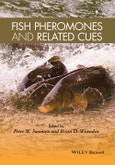Pheromones are chemical cues that pass between members of the same species that convey specific, adaptive information. These cues, and related chemicals whose function are less well defined, are especially important to fishes because of their aquatic environments and complex behaviors. Pheromones are also of increasing interest in both basic and applied aspects of fish biology because they can be used to manipulate fish behavior and may explain phenomena such as fishery collapse. Fish Pheromones and Related Cues provides a timely synthesis of this growing body of research in freshwater and marine species and explores everything from how these chemical signals evolved, are produced, released and then processed, and finally to potential applications in fish culture and conservation.
Fish Pheromones and Related Cues opens with a useful overview on the theory of chemical communication and definitions. Chapters then progress by examining the biological importance of pheromones in inter- and intra-species communication, the role these chemical cues play in a variety biological functions from reproduction to predation, and then how they evolved and are detected and recognized by fish nervous systems. Final chapters provide valuable insight into how pheromones can be measured, how pheromonal disruption can explain effects of environmental pollution, and lastly how they pheromones are being applied in real-world efforts to culture fish species and to conserve our wild populations and control invasive species.
With far-reaching economic, evolutionary and ecological implications, Fish Pheromones and Related Cues will be an essential volume for anyone working in the fields of chemical communication, fish biology, fisheries science, aquatic conservation, ecology, invasive species control, and aquaculture
Table of Contents
Contributors ix
Preface xi
Chapter 1 Introduction to Pheromones and Related Chemical Cues in Fishes 1
Peter W. Sorensen
Chapter 2 Species-Specific Pheromones and Their Roles in Shoaling, Migration, and Reproduction: A Critical Review and Synthesis 11
Peter W. Sorensen and Cindy Baker
Chapter 3 Hormonally Derived Pheromones in Teleost Fishes 33
Norm Stacey
Chapter 4 Conspecific Odors as Sexual Ornaments with Dual Functions in Fishes 89
Lynda D. Corkum and Karen M. Cogliati
Chapter 5 Intraspecific Social Recognition in Fishes via Chemical Cues 113
Ashley J.W. Ward
Chapter 6 Chemical Cues That Indicate Risk of Predation 131
Brian D. Wisenden
Chapter 7 The Cue–Signal Continuum: A Hypothesized Evolutionary Trajectory for Chemical Communication in Fishes 149
Brian D. Wisenden
Chapter 8 Olfactory Discrimination of Pheromones 159
Stine Lastein, El Hassan Hamdani and Kjell B. Døving
Chapter 9 Measuring and Identifying Fish Pheromones 197
Michael Stewart and Peter W. Sorensen
Chapter 10 Effects of Pollutants on Olfactory Detection and Responses to Chemical Cues Including Pheromones in Fish 217
K. Håkan Olsén
Chapter 11 Pheromones in Marine Fish with Comments on Their Possible Use in Aquaculture 237
Peter Hubbard
Chapter 12 Applications of Pheromones in Invasive Fish Control and Fishery Conservation 255
Peter W. Sorensen
Afterword 269
Index 271
Color plates appear between pages 144 and 145.








